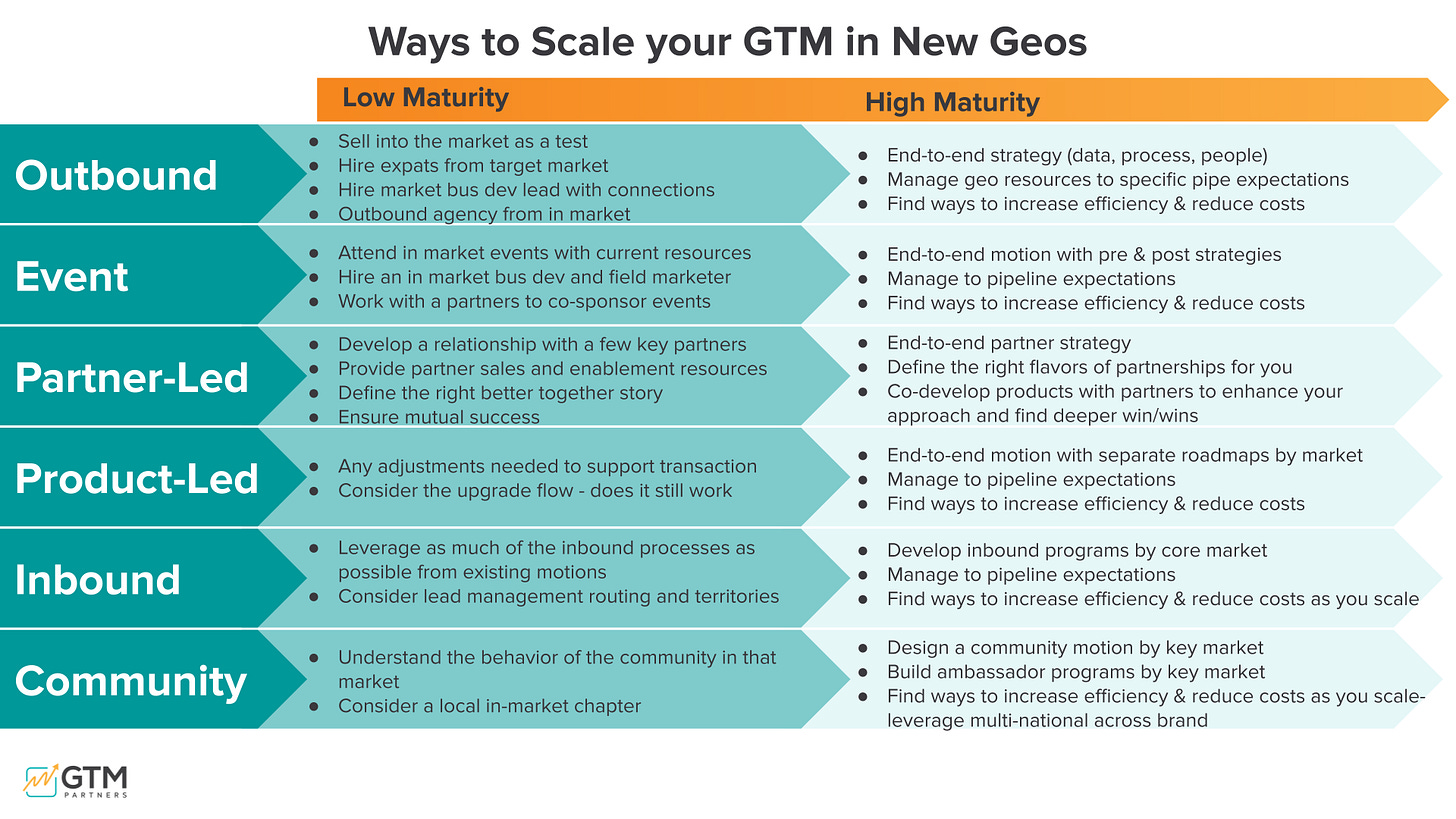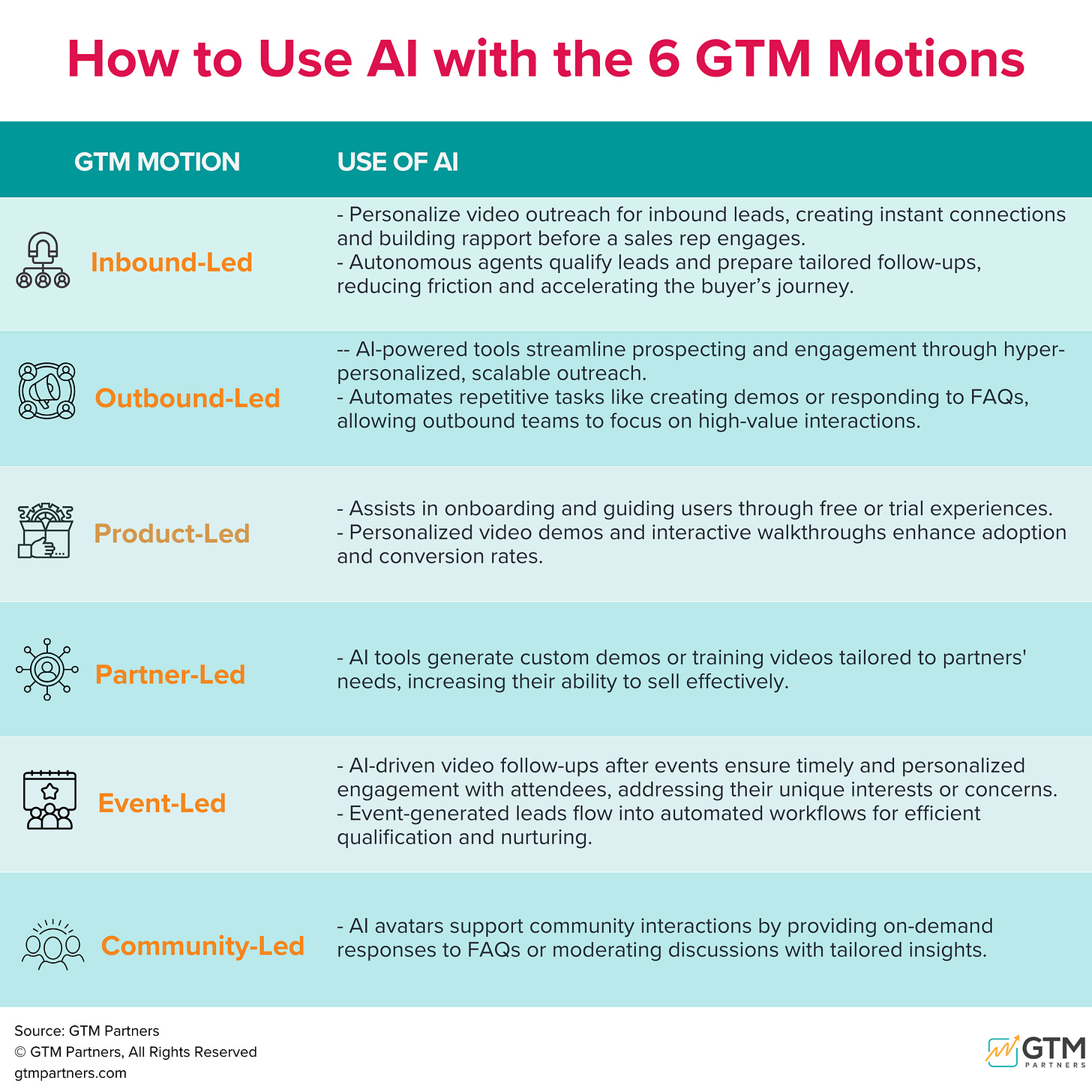Filters
New Research: How Enterprise GTM Teams are Scaling Globally
Thanks for being one of over 175,000 forward-thinking GTM Leaders who subscribe to this weekly research note.
This week’s research note includes:
GTM Research: Going Global: what changes (and what doesn’t) in GTM when you expand internationally
Spotlight: GTM Certified Partner Sue Foley
Upcoming Events
New Research for Enterprise GTM Teams Trying to Scale Globally
At GTM Partners, we’ve helped companies scale across verticals, revenue bands, and markets—but one of the biggest transformations a GTM team can undergo is expanding into a new geography.
International expansion can feel like starting from scratch. But it’s not.
It’s more like building a second home on the same foundation.
You still need the cornerstones of go-to-market, and you still need the GTM Operating System.
But you need to re-inspect every beam and bolt to see if it holds up in a new cultural, regulatory, and economic environment.
Cultural buying preferences can surprise you.
For example, these are all things we’ve heard from our clients about international GTM:
“They move slower in Europe than in the US.”
“Spanish buyers don’t want to have a discovery call or build rapport, they want to be wowed by our knowledge.”
“Marketers are less feature focused in the UK. They are used to it due to GDPR constraints.”
“If Americans like it, of course all other English speaking countries will as well.”
“German buyers are generally more formal and reserved.”
Are these statements objectively and universally true?
That doesn’t even matter as much as knowing that the buyer’s journey isn’t universal—and your GTM must flex to meet it.
Let’s walk through what does change when you cross borders—and what doesn’t.
Start With Why: Not Every Market Is Worth Entering
If you don’t have a really good reason to expand into a new geography, don’t.
Too many companies pursue geographic expansion prematurely—often to please investors, chase a competitor, or fulfill a vanity goal.
But geographic expansion isn’t just a bigger version of sales expansion. It’s a deeper, more complex transformation.
Before entering a new region, you must:
Clearly define who your ideal customer is in that market.
Understand why your value proposition is uniquely suited to them.
Assess whether your existing product has a fit—or if it needs to evolve.
In the following research note, we’ll go over these four considerations:
Product
Competition
GTM Motion
Resources
Product: The Foundation (That Might Not Translate)
Product-market fit plays an oversized role when you’re expanding into a new country. Just because your product sings in the U.S. doesn’t mean it will translate—literally or metaphorically—across the Atlantic.
Ask:
Do buyers in this market value the same outcomes?
Are there feature gaps or integrations required for local compliance?
Are there hidden friction points in UX, language, or workflows?
Read more about how to tell if you’re in Product-Market Fit or take the MOVE Assessment to know for sure.
Competition: Don’t Assume You’re the Default Choice
In your home market, you might be the category leader—or at least a known quantity.
But when you enter a new geography, everything resets.
Your brand equity doesn’t automatically carry over.
In fact, you may be walking into a market where your competitors have already built deep roots, trusted relationships, and local credibility.
That’s why a thorough competitive analysis isn’t optional—it’s mission-critical.
Ask yourself:
Who are the entrenched players in this market?
Don’t assume your usual competitors are the threat. In new regions, there may be dominant local solutions you’ve never heard of, with loyal customer bases and culturally attuned offerings. They may not be more advanced—but they are more trusted.How will you be perceived?
Will you be seen as a premium, innovative disruptor—or an overpriced outsider who doesn’t get the local market? Your pricing, packaging, and positioning may need to shift dramatically. In some markets, “American” might signal prestige. In others, it may imply you’re out of touch.Do your U.S.-based differentiators actually resonate?
Features that wow U.S. buyers may be irrelevant—or even counterproductive—elsewhere. For example, a “move fast” ethos might appeal in the U.S., but turn off more methodical buyers in Germany or Japan. Compliance, privacy, integration, and service expectations vary significantly by region.What messaging will land (and what will fall flat)?
You may need to adapt your pitch, not just translate it. Consider how cultural context changes perception. A “10x your pipeline” promise might excite U.S. prospects and alienate U.K. buyers who value trust and longevity over hype.Are there adjacent or indirect competitors?
In less mature markets, buyers might still be solving the problem manually or with general-purpose tools. In that case, your biggest competition isn’t another vendor—it’s inertia.
In short: You’re not just competing on features. You’re competing on familiarity, relevance, and trust. Don’t just export your U.S. battle plan—build a new one for the terrain you’re stepping into.
GTM Motion: Tailor It—Don’t Copy-Paste
You don’t need to start over, but you do need to rethink your GTM motion.
In some cases, your inbound engine may carry over. In others, you’ll need to lead with outbound, partners, or events. And the maturity level of each GTM motion will vary based on the market, the team, and the pace of entry.
Think of GTM maturity as a spectrum:
Low maturity = testing, localizing, adapting.
High maturity = end-to-end programs tailored to pipeline expectations by region.
You’ll also need to be mindful of localized GTM mistakes, like:
Overlooking regulatory issues
Thinking logistics instead of strategy
Failing to plan internal alignment (especially during M&A)
Poor localization in marketing and CX
Outbound
Early stage (Low Maturity):
Start small. Test the market. You might sell directly, hire expats, or tap an in-market agency to gain traction.
Fully scaled (High Maturity):
Build a true outbound engine with local data, processes, and talent. Align headcount to pipeline expectations and optimize for efficiency.
Event-Led
Early stage:
Attend events using your existing team (yes, that might mean flying people in). Look for co-sponsorships and local business development help.
Fully scaled:
Run full-funnel event programs with pre- and post-event strategy. Map them directly to pipeline goals and iterate to reduce costs.
Partner-Led
Early stage:
Identify a few key partners and provide basic enablement. Align on shared goals and a compelling "better together" story.
Fully scaled:
Develop a formal partner strategy tailored to the region. Co-create products or services to deepen alignment and unlock win-win growth.
Product-Led
Early stage:
Test for product fit. Do transactions flow? Does your upgrade journey make sense in this market?
Fully scaled:
Build regional product roadmaps. Monitor metrics by market. Optimize for conversion, stickiness, and scalability.
Inbound
Early stage:
Re-use what you can from existing inbound systems—like forms, flows, or lead scoring. But be mindful of routing and response time.
Fully scaled:
Create local inbound programs with regional content, SEO, and nurture tracks. Manage funnel efficiency and geo-specific ROI.
Community-Led
Early stage:
Observe how communities in the new region engage—online and offline. Pilot a local chapter or social presence.
Fully scaled:
Design full community motions by region. Build ambassador programs. Scale across borders with a shared community brand.
You don’t need to activate every motion in every region on day one. But knowing where you are—and where you’re headed—can keep your international expansion both focused and flexible.
Resources: Your Team Will Make or Break Your Entry
Too many companies try to enter a region with the wrong team—or worse, with no team.
You need resources on the ground. This might mean hiring expats, building regional pods, or recruiting experienced operators with local connections. If you can't support customers well post-sale, don’t enter the market.
And if you enter via acquisition, be extra careful: unplanned internal competition or confusion can erode value on day one.
Final Thoughts: You Can’t Scale What You Don’t Understand
Scaling your GTM across geographies is doable—but not without discipline. You need to understand why you’re entering, how the market behaves, and what to adjust across your GTM pillars.
Because GTM isn’t one-size-fits-all. And international GTM? It’s more like tailoring a suit in a country where the measuring tape works differently.
If you’re expanding internationally, or thinking about it, book a call with Bryan and Sangram to see how we can help.
Spotlight: GTM Certified Partner Sue Foley
As the GTM Certified Partner program expands, we’re excited to share our first partner in Australia: Sue Foley!
Sue Foley isn’t just a fractional CMO—she’s a growth architect, brand builder, and strategic storyteller with a passion for taking businesses from good to great. With over 20 years in high-growth environments, she specializes in connecting strategy to results, turning complex challenges into clear, actionable playbooks that drive real impact.
As the founder of MarketCraft GTM, Sue helps scale startups, accelerate SaaS businesses, and guide service companies from problem-market fit to category leadership. She knows what it takes to build modern marketing functions that move fast, align cross-functional teams, and hit aggressive growth targets.
If you’d like to be a certified GTM Partner like Sue and many others,
we’d love to talk to you about how to make that happen.
Events: Where We’ll Be Speaking in 2025
(DM Sangram for discount code to attend or slides for these events)
Catch us at our upcoming keynotes and webinars:
B2SMBI Leaders’ Forum (for selling AI-infused products to SMBs at scale): How to go from problem-market fit to product-market fit to platform-market fit, May 14-15 in Sonoma
SOUTHBOUND (hosted by RevPartners): Workshop at The Growth Summit for Revenue Leaders, May 21 in Atlanta - use “RPPartner” for 50% ticket
The DemandXChange (hosted by TrustRadius): No Fluff, No Complexity: Build Your GTM Strategy in 8 Steps on One Slide Keynote, Live on June 5th at 12 pm ET
How Data Powers GTM Success: Systems, Signals, and Strategy (hosted by Sprout.ai), June 18 on LinkedIn Live
INBOUND (hosted by Hubspot), September 3-5 in San Francisco
DRIVE 2025 (hosted by Exit Five). September 10-11, Burlington, VT
Hope to see you soon, and please reach out if we can help with anything.
Love,
Bryan and Sangram





